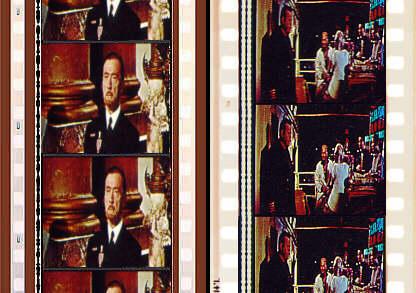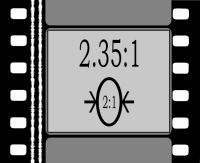 |
|
|
|
|
|
|
|
 |
 |
 |
 |
|
|
 |
 |
 |
|
|
 |
 |
 |
Posted: |
Aug 19, 2010 - 1:51 PM
|
|
|
|
By: |
Ed Nassour
(Member)
|
2.66:1 was the aspect ratio of Cinemascope before the optical soundtrack was applied. "The Bridge on the River Kwai" always had an optical soundtrack so while this extra area to the left of the frame was exposed onto the film's negative, it wasn't properly framed for that wide a picture. The camera operator saw on the viewfinder the proper framing lines and they didn't include the soundtrack area. So the proper aspect ratio for the film is 2.35:1.
Originally Cinemascope ran with a separate interlocked magnetic track containing four discreet channels. "The Robe" played that way in key theaters. So "The Robe" was properly framed for 2.66:1. Then shortly after, the prints were striped with the four magnetic channels which cut into the frame. That reduced the aspect ratio down to 2.55:1.
Then due to pressure from exhibitors who refused to purchased the expensive sound equipment, Fox came up with what they called 'magoptical' where a standard optical track was included along with the four magnetic stripes. That reduced the aspect ratio to 2.35:1 (actually closer to 2.39:1)
Robert Harris contradicts this:
"Kwai was beautifully shot, albeit with scope adapters on Arri bodies. 2.55 aspect ratio, fully prepared for a magnetic opening...I have both background with the elements, as well as faith in Mr. Crisp."
If it was to be issued with four magnetic stripes on the print along with the optical soundtrack, the aspect ratio would have been 2.35:1 since by 1957 'magoptical' prints were standardized. So if the film was framed for 2.55:1, that was a mistake since they knew full well the film would be shown in theaters with an optical track. Framing an area that's not going to be used means it won't be properly centered.
Once the original full frame 1.33:1 silent camera aperture has an anamorphic squeeze applied, when projected the aspect ratio becomes 2.66:1, that is if a print is projected without any type of soundtrack. Apply the magnetic stripes and the frame is reduced to 2.55:1. Add the optical soundtrack and it's reduced to 2.35:1.
If the film was to have a stereo presentation, is Harris saying they mixed it in stereo? And if so, what became of that mix?
I saw the film in its original run and it was definitely in mono.
A 35mm Cinemascope print with four magnetic stripes:

And below on the left a 'magoptical' print and on the right a standard Cinemascope optical sound print:

The magoptical is from "The Man Who Never Was (1956).
 |
|
|
|
|
|
 |
One of my top ten favorite films so I hope I'll get a chance to see it somewhere. Hopefully it will lead to a nicely mastered Blu-ray release. I'm still sporting the laserdisc version of it!
THe Castro in SF has it for a week in September!
|
|
|
|
|
 |
Robert Harris contradicts this:
"Kwai was beautifully shot, albeit with scope adapters on Arri bodies. 2.55 aspect ratio, fully prepared for a magnetic opening...I have both background with the elements, as well as faith in Mr. Crisp."
If it was to be issued with four magnetic stripes on the print along with the optical soundtrack, the aspect ratio would have been 2.35:1 since by 1957 'magoptical' prints were standardized. So if the film was framed for 2.55:1, that was a mistake since they knew full well the film would be shown in theaters with an optical track. Framing an area that's not going to be used means it won't be properly centered.
Once the original full frame 1.33:1 silent camera aperture has an anamorphic squeeze applied, when projected the aspect ratio becomes 2.66:1, that is if a print is projected without any type of soundtrack. Apply the magnetic stripes and the frame is reduced to 2.55:1. Add the optical soundtrack and it's reduced to 2.35:1.
If the film was to have a stereo presentation, is Harris saying they mixed it in stereo? And if so, what became of that mix?
I don't think he's saying that. He's saying the camera was set up for framing at 2.55 and that the materials and elements and paperwork at Sony support this.
 |
|
|
|
|
|
 |
 |
 |
Posted: |
Aug 19, 2010 - 4:21 PM
|
|
|
|
By: |
Ed Nassour
(Member)
|
Robert Harris contradicts this:
"Kwai was beautifully shot, albeit with scope adapters on Arri bodies. 2.55 aspect ratio, fully prepared for a magnetic opening...I have both background with the elements, as well as faith in Mr. Crisp."
If it was to be issued with four magnetic stripes on the print along with the optical soundtrack, the aspect ratio would have been 2.35:1 since by 1957 'magoptical' prints were standardized. So if the film was framed for 2.55:1, that was a mistake since they knew full well the film would be shown in theaters with an optical track. Framing an area that's not going to be used means it won't be properly centered.
Once the original full frame 1.33:1 silent camera aperture has an anamorphic squeeze applied, when projected the aspect ratio becomes 2.66:1, that is if a print is projected without any type of soundtrack. Apply the magnetic stripes and the frame is reduced to 2.55:1. Add the optical soundtrack and it's reduced to 2.35:1.
If the film was to have a stereo presentation, is Harris saying they mixed it in stereo? And if so, what became of that mix?
I don't think he's saying that. He's saying the camera was set up for framing at 2.55 and that the materials and elements and paperwork at Sony support this.
Then cinematographer Jack Hildyard and especially David Lean weren't as knowledgeable as we've been led to believe they were.
Look, it's simple. By the mid-fifties, all Cinemascope prints carried an optical track. That means all Cinemascope films were composed for 2.35:1. They had to be. Some were mag striped such as all the Fox Cinemascope films. Warner Brothers made mag striped Cinemascope prints as did MGM.
Then if this is the case, why frame inaccurately? It makes no sense whatsoever.
Up until Universal did a sort of restoration on the Lugosi version of "Dracula," all the prints and TV transfers were framed wrong. The reason was back when "Dracula" was released, the sound was on a Vitaphone disc. So the cameraman framed to expose the entire frame. Later on when Vitaphone was discarded in favor of optical sound-on-film, the prints had the frame cut into on the left side to handle the optical composite soundtrack. "Dracula" had its production sound recorded onto disc. The rerecording process used discs which is why the soundtrack has so many ticks and pops. Unlike "Dracula," the Lean film was framed for what they knew to be the standard composition to handle the optical soundtrack.
I don't know how much more clearly I can describe why what Harris said is wrong.
Here's an example of a 35mm frame showing the optical soundtrack.

This is how the film was issued. If they framed it for 2.55:1 then when the soundtrack was applied it robbed the frame of width. Had they framed dead center expecting only a 2.55:1 4-track stereo release that would have gone contrary to what was the standard.
So if Harris plans to use the entire width of the frame, as to how much a framing error will occur, we'll have to wait and see. What will be telling is if the titles are shifted over to the right. If this is the case, when they digitize it they will need to center them.
 |
|
|
|
|
|
 |
I hope this gets some sort of re-release, even if just to art houses. We've got enough of those to guarantee a screening in Fort Worth/Dallas. I'll be happy to make one of my infrequent visits to a movie theater for this one on a big screen.
|
|
|
|
|
|
|
|
|
|
|
|
|
|
|
|
|
 |
I hope this gets some sort of re-release, even if just to art houses. We've got enough of those to guarantee a screening in Fort Worth/Dallas. I'll be happy to make one of my infrequent visits to a movie theater for this one on a big screen.
Are they going to make 35mm prints along with the digital version? There are still lots of theaters using film projection.
Yes, Sony has struck new 35mm prints - I'll be booking and running one later this year.
|
|
|
|
|
|
|
|
|
|
|
|
|
 |
I get the impression from the article that digital projection was used to show the film in El Paso. I too wonder if any film prints will be made. Robert Harris believes that, after a digital restoration such as this, it is important to output the new negatives onto film for long-term storage purposes. I would suspect that at least one actual film print would be made for the studio archives.
I know Fox will herewith re-issue all 70 mm films (PATTON et al. ) w/ digital sound (DTS)
Warners will be replacing 35mm prints with digital for future restorations and re-issues
bruce
|
|
|
|
|
|
|
|
|
 |
the good news is with this new restoration we will end up seeing a wider picture using more negative area so on paper it should be sharper. And for once the titles will be centered properly.
the bad news is the added picture will most likely be projected on the curtains and walls!
d'oh!!!!!!!!!!!!!!!!
|
|
|
|
|
|
|
|
|
 |
well, i guaranteee movie houses will spill the image
brm
|
|
|
|
|
 |
 |
 |
Posted: |
Aug 25, 2010 - 3:10 AM
|
|
|
|
By: |
Bob DiMucci
(Member)
|
Here's the Blu-ray announcement, from "The Digital Bits":
Sony has just finally announced the title as a 2-disc Blu-ray Disc/DVD Combo Collector's Edition, due to street on 11/2 (SRP $34.95). In addition to HD and SD versions of the film (presented in the original 2.55:1 aspect ratio, fully restored and mastered from a 4K scan with audio in newly-remixed DTS-HD MA 5.1), extras on the 2-disc set will include a new Crossing: Picture-in-Graphics viewing mode, an exclusive new retrospective documentary covering everything from the adaptation of the original Boulle novel to the restoration, 2 featurettes (An Appreciation by John Milius and Rise and Fall of a Jungle Giant), rare audio of William Holden narrating the film's premiere events, a USC short film introduced by Holden, footage of holden and Alec Guinness on The Steve Allen Show and a photo gallery. The package will also include a 35-page book with liner notes and production photos, as well as original lobby card replicas. As we noted on 7/30, Amazon.com is already taking pre-orders on the release - they currently have it priced at 30% off, or just $24.95 - not bad! Here's a look at the packaging...

 |
|
|
|
|
|
 |
what, no 3-d?!
|
|
|
|
|
|
|
|
|
 |
Turner Classic Movies will be showing the restored "The Bridge On the River Kwai" in the U.S. on Friday, November 5, at 8 PM, followed by Laurent Bouzereau's "Making Of" featurette at 11 PM.
|
|
|
 |
 |
 |
|
|
 |
 |
 |
| |
|
|
|
 |
|
 |
|
|
|


